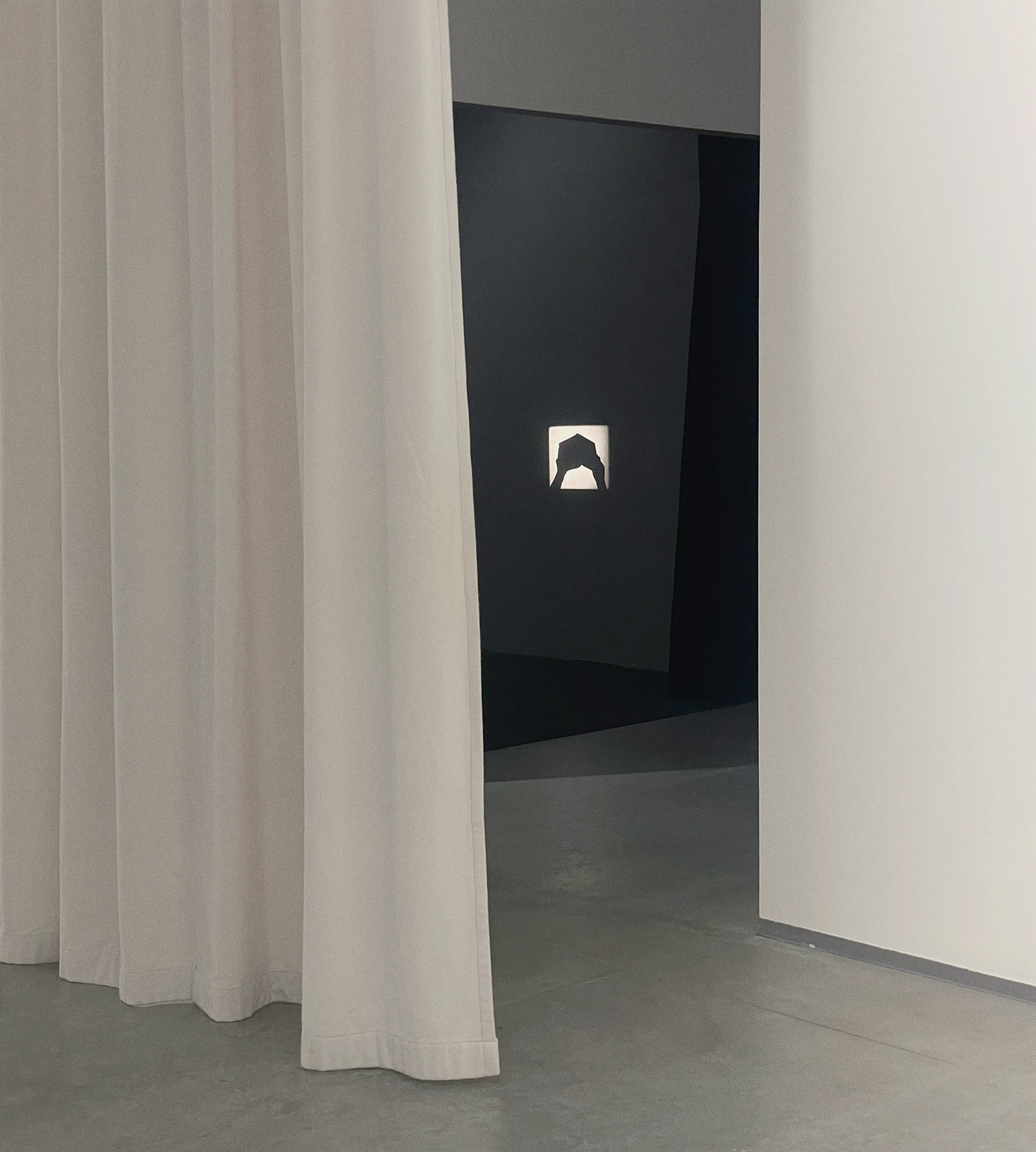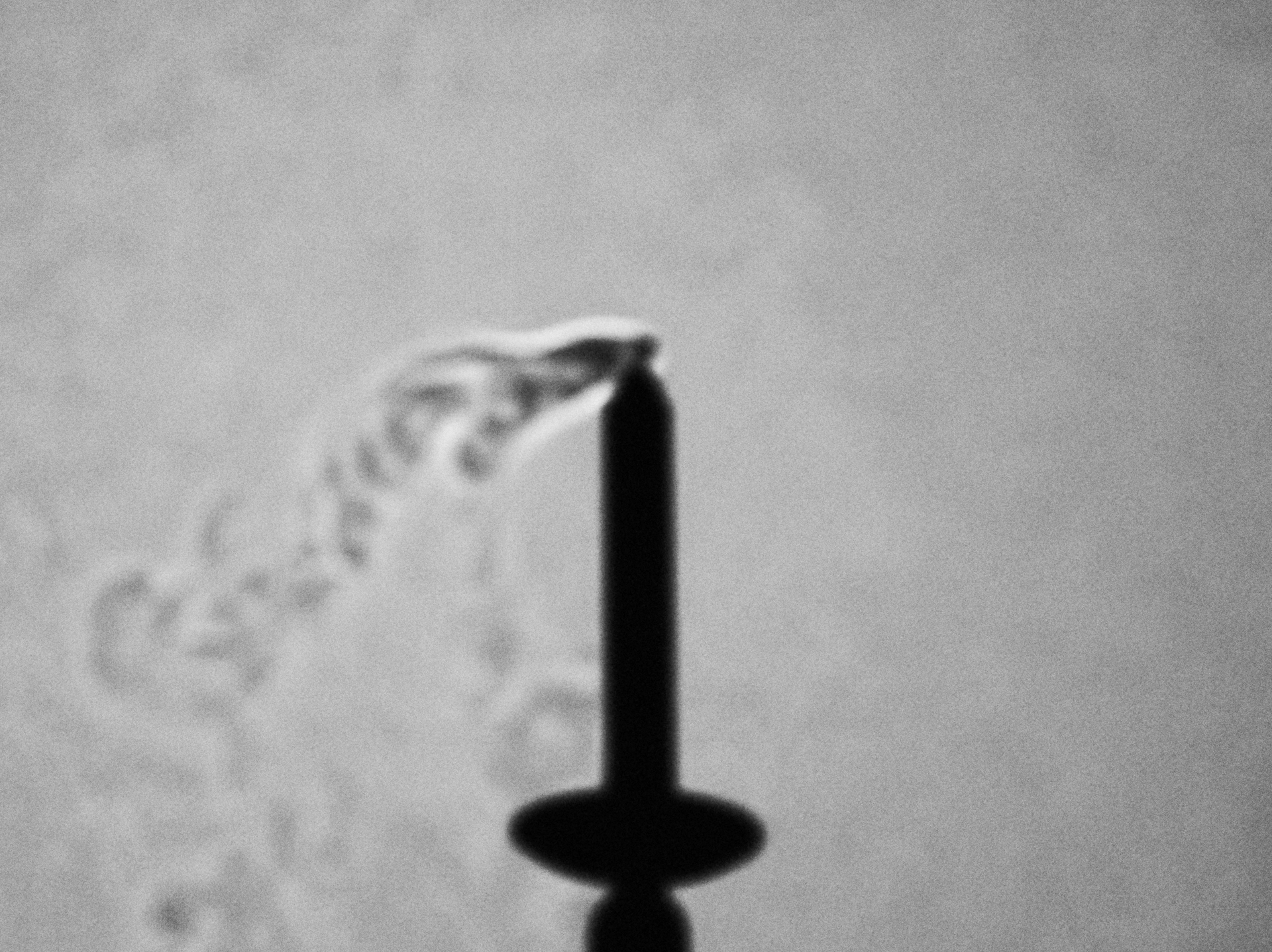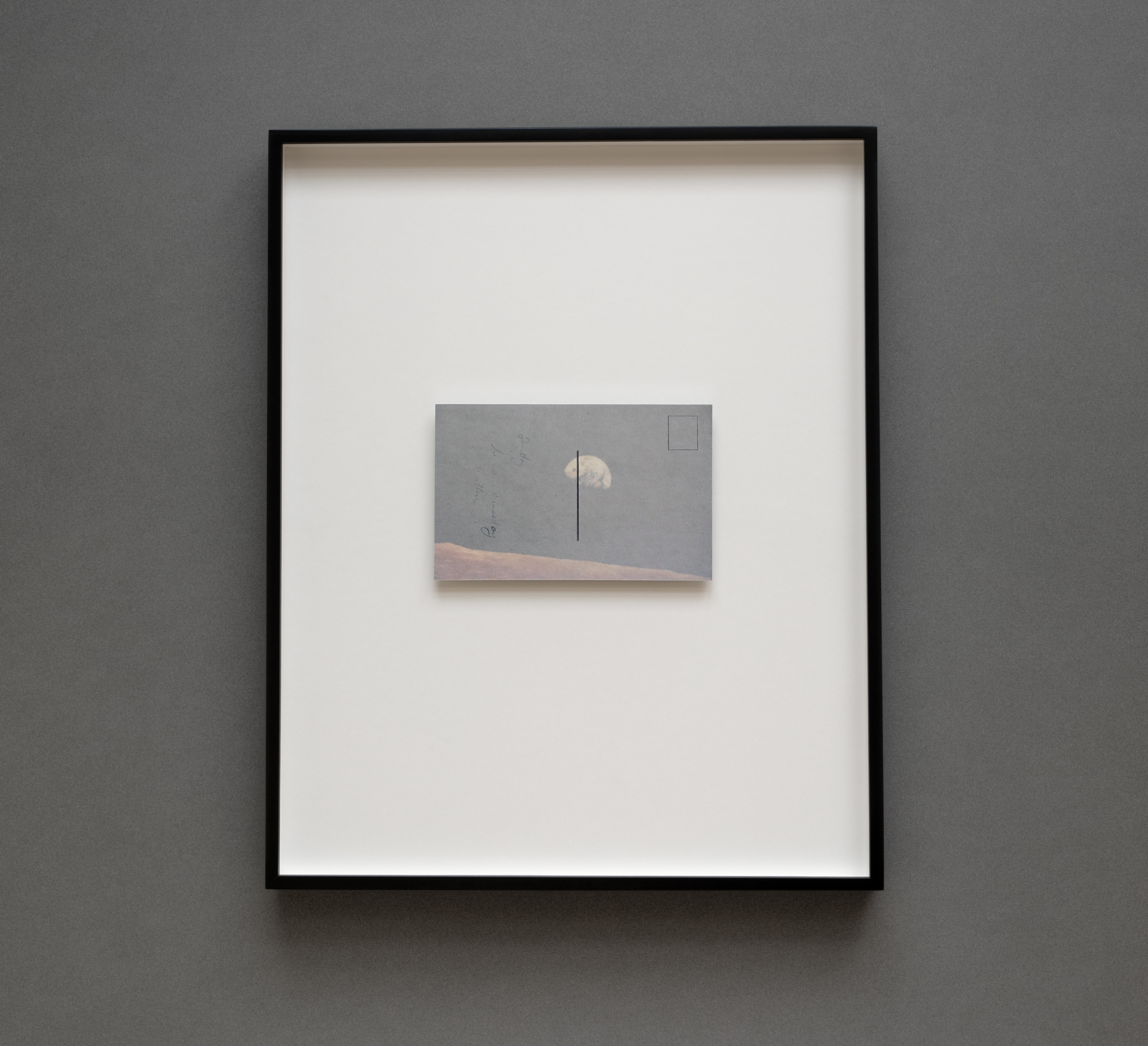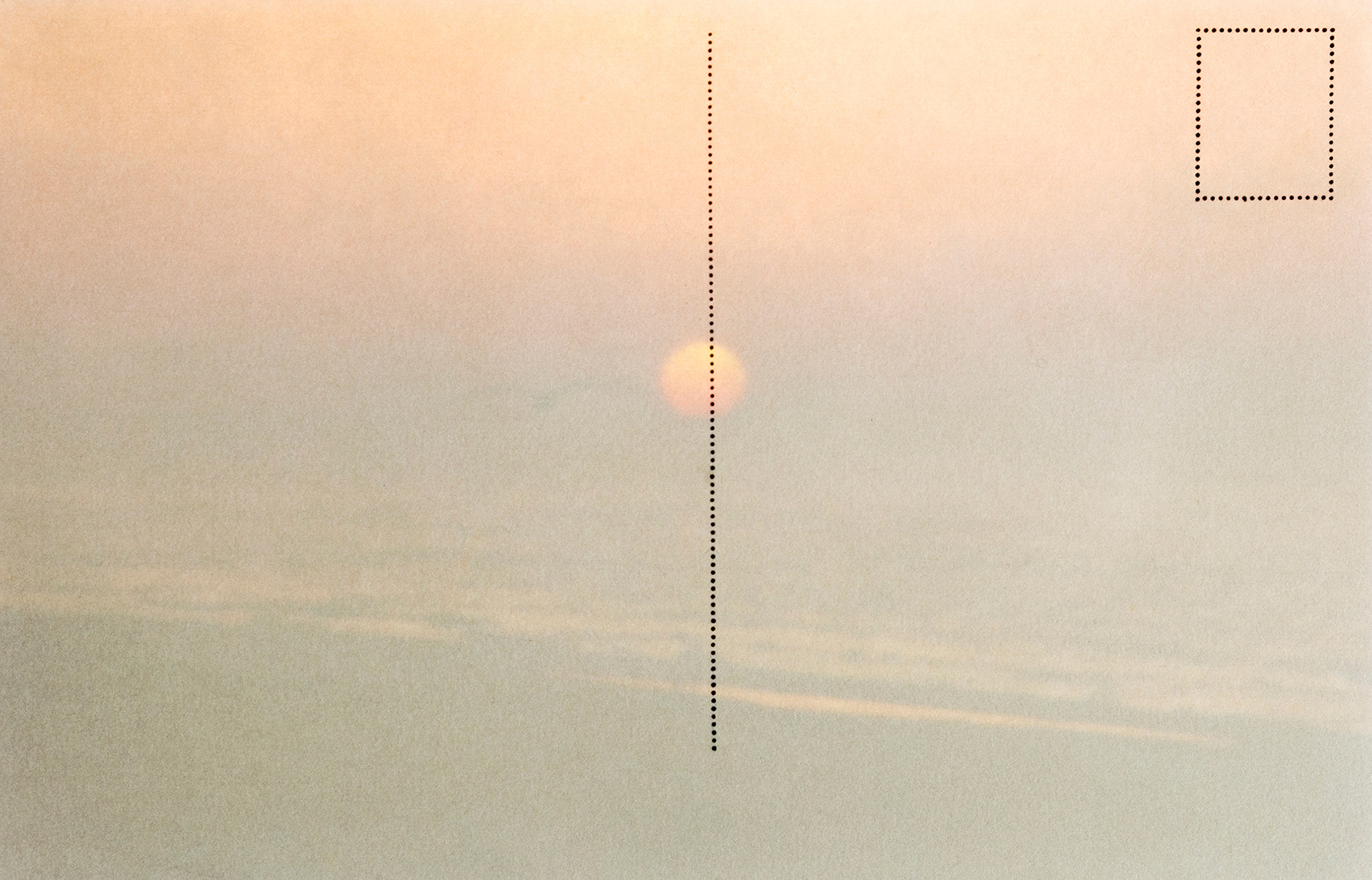Juuso Noronkoski
The Reader, the Light
17.10. - 23.11.2025 w/
Tanja Koljonen
@
Porvoon Art Hall, Porvoo, FI


Still from The Reader, the Light, 2025
16 mm film, 2 min loop
w/ Tanja Koljonen
~~~

Verso II, 2025
Pigment print mounted on aluminum,
10 cm x 15 cm (frame 42 x 30 cm)

Verso, 2025
Pigment print mounted on aluminum,
10 cm x 15 cm

Landscape Without a Night, 2025
Collage consisting of two pigment prints,
90 cm x 66 cm
~~~

Device No.8, 2024
Sunlight focused on color negative (8x10”), brass artist frame, magnifying lens,
21 cm x 26 cm x 24 cm

Synopsis, 2024
Diptych, lumen print mounted on aluminum, brass artist frame
2 x (30,5 cm x 24cm)
~~~
Two Million Seconds
8.4. - 30.4.2023 w/
Tuomo Rainio
&
Joonas Siren
@
Forum Box, Helsinki FI



Plateau (First Evaporation), 2023
Diorite, 30 million year old fossilwater.
200 x 150 x 4 cm (dimension can vary)
The hollows cut into the stone slabs are filled with fossil water collected from a borehole in Outokumpu. The water has been kilometers deep inside the bedrock for 30 million years. At the beginning of the exhibition, the water is poured onto the slabs, from where it gradually evaporates, leaving dry salt crystal ponds behind.


Days (Spring, Summer, Late Autumn) & Nights (Spring, Summer, Late Autumn), 2023
The polished brass arches symbolize the sun’s journey across the sky, illustrating the varying lengths of days throughout the calendar year. The arcs on the lumen prints symbolize the dark hours of the day. These silver gelatin papers are exposed to direct sunlight by covering and uncovering parts of the paper’s photosensitive surface. The papers are neither developed nor fixed, so the colors change and darken as they react to ambient sunlight during the exhibition. The arcs in the images gradually disappear into the darkening paper.
_446A0100_1920.jpg)
The View (Spring), 2023
Framed silver gelatin prints
2 x 56cm x 46cm
_1_1920.jpg)
The View (Autumn), 2023
Framed silver gelatin prints
2 x 56cm x 46cm


The Fog, 2023
Framed silver gelatin prints
3 x 35cm x 25cm
~~~
NEW NORTH - NEW PERSPECTIVES @ Atelier NOUA, Bodø, Norway
03/12 2022 - 15/01 2023
_1920.jpg)
Worlds (I), 2022
27 x 32 cm, Collage with found postcards

Device No.4, 2021
Focused sunlight on photographic negative (4x5"), brass, magnifying glass | 13 x 13 x 20 cm
~~~
Winter Garden (2nd Variation) @ Studio Mältinranta, Tampere, FI
22.10. - 8.11.2022
_installation_1920.jpg)

Winter Garden, 2022
Projector, hd-video 60 min loop, glass casing (150 x 100 x 50 cm), wooden pedestal.
_1920.jpg)
Untitled (Entrance), 2022
Reel-to-Reel tape recorder, reel tape (30 sec loop), bearing guides.
~~~
Solo show: Winter Garden at Galleria Uusi kipinä, Lahti, FI | 11.8. - 29.8.2021


So Called Birth Room (interior), 2021
Photogravure | 53 x 63 cm

You can go up the stairs, walk past the
hall and step into the room in which the
writer is said to have been born. The room
is almost empty with only a window at the
back. You can look through the window
and see a familiar view.
The view is familiar because you know the
writer, and their words have also helped you
discover yourself. After the writer passed
away, the writer’s home took their place in
your mind. Its rooms, halls, and staircases
have replaced the writer’s thoughts. Its
windows and doors, the writer’s expression.
You move through the doors, from one
thought to another, and at the windows you
can reminisce.
In your memories, you go back to an image
of a destroyed city. You stand above it, as
if on a tightrope, forever taking the same
step but never crossing the abyss. You can
feel the collapsed walls and the windows
without rooms. In your mind, the ruins are
unfinished sentences. The windows without
rooms are stories without the storyteller.
The destroyed city is like speech that falters,
an expression without a thought.
You understand why they had to rebuild the
writer’s home. You understand that walls are
necessary. Without the walls, you would see
everything but understand nothing.
At that moment, you hear a sound in the
back of the room and see that the landscape
has been covered in snow. You breathe in
the air coming from the city behind the
window. When you leave, you leave the
window open and let the snow fall on the
floor.
_1920.jpg)
So Called Birth Room (exterior), 2019
Photogravure | 53 x 63 cm


Sleepy Geometry, 2019
Uv-print on glass, steel, dimension variable
@ Spinnerei Rundgang, Leipzig, 2019
~~~
Nurture, Nature @davidbehning galerie, Düsseldorf, DE, 13.3.2020 - 19.6.2020

~~~
Group show: Trees Are Inviting the Wind @ Willem Twee Kunstruimte, Den Bosch, NL, 2019

~~~
FIDA residency @ Fabrikken, Copenhagen DK, Aug - Sept 2019

~~~
Solo show: One Millimeter Away From Stillness @ Gallery Taik Persons, 20th Feb - 20th Apr 2019

One Millimeter Away From Stillness, Gallery Taik Persons, Berlin, DE

One Millimeter Away From Stillness, Gallery Taik Persons, Berlin, DE

Drifter, 2018.
Four framed pigment prints, 28 x 36 cm each
Despite the rain, I have spent every hour of daylight by the river
that runs through the city. Walking along the riverbank has kept me from
going insane here in the inland. Thoughts flow while walking, they
ripple like hot air near the horizon and disappear instantly like a wet
footprint. If I didn’t have this skin, a boundary that keeps all my
fluids inside, I would surely evaporate myself before arriving at the
river delta and finally the ocean. The journey to its source is equally
as long. It’s strange to think about a small creek somewhere on the
mountainside. That all these cities where built in the same riverbed.
That, from the beginning of time, the same water has been distorting the
heads of the people looking at their reflections.
My studio is in one of the city’s rare buildings that survived the war.
I saw some old photos of the buildings façade. The same window I’m
now writing at was draped (within a fairly short period of time) with
the symbols of two dictatorships that fought each other. It’s remarkable
how much these, now imaginary, drapes becloud the space. As I look out
my window and see the tall buildings replacing the ruins, I wonder, is
it really the reflection on the wet glass that distorts the head, or in
fact, is it the head that distorts the view behind it?
A while ago I met a geologist who studies water found deep inside the
earth’s crust. According to her, the water had been inside the rock for
30 million years! After it rains, water pays a visit on the ground,
then evaporates, condenses into clouds and rains back down. However,
the water cycle kilometers deep inside the earth is temporally more like
the rock cycle and other geological processes. With my experience of
time, it is very difficult, if not impossible, to fathom the length of
these events. The geologist told a joke that illuminated this temporal
relativity, but I can’t remember it anymore.
There is a German word for describing the contradictory nature of
experiencing time: Ungleichzeitigkeit, non-simultaneity. I think the
concept is meant to help us understand our own relationship with the
present as experienced by someone else. It also reflects those moments,
which often occur when looking at photographs, when the past and the
present float around in my consciousness and I can’t decide which one
feels more immediate.
I read somewhere that the recent floods in Venice made Basilica Di
San Marco age 20 years in one day. I thought about the water that is
tens of millions of years old, unreachable by the everyday cycle of
life: How long would it take for that water to evaporate? And how the
water would wear the head of the one counting the days while it
vanishes.
_1920.jpg)
Untitled (Second Evaporation), 2019.
Black granite, 30 million year old borehole water evaporating / evaporated
138 x 96 x 4 cm

All That Is Solid Melts into Air, 2019
Framed pigment print, 52 x 62 cm

The Blind Man II (Hours of Light), 2018
Framed pigment print, 24 x 18 cm
~~~
Solo show It Feels Like the Days Are Getting Longer Again... w/ Mikko Rikala @ Sinne, Helsinki 30.11. 2018 - 6.1.2019


Device No:1 (The Madness of the Day), 2018.
Focused sunlight focused on exposed negative, magnifying glass, brass, 18 x 10 x 23 cm.

The Blind Man II (Hours of Darkness), 2018
Framed pigment print, 24 x 18 cm
~~~
Seeing Without a Seer @ Looiesgracht 60, Amsterdam, 20. - 30.9.2018

To See How the Moon Sees, 2016
Rolled pigment print 150 x 200 cm, steel tripod 100cm (hight), lightspot, text.


~~~
Emerging 2018 @ Galerie Anhava, Helsinki 9.8. - 2.9.2018


A Passage to the Other Night, 2018
Photographic negative, brass, found obelisk, 91 x 20 x 10 cm.

Solstice, 2018
Silver gelatin print, brass artist frame, 28 x 36 cm

Library of Unfinished Sentences, 2018
Pigment prints mounted on brass, acrylic glass, 17 x 12,5 x 3 cm.
Joseph Grand is a fictional character in Albert Camus’ novel 'The Plaque'.
In the novel Grand is portrayed as a pitiable yet slightly comical municipal
clerk who keeps track of the death toll in the plaque-ridden French Algerian
town. In his free time Grand is a writer, and as a writer the most notable
feature is his trouble with language. His manuscript that goes on for dozens
of pages only contains countless variations on the first sentence. Somehow
Grand can never choose the right words or the words he choses seem to loose
their potency by the time they are written down. The inability to express himself
also caused Grands wife Jeanne to leave him. But Grands indecisiveness is not
necessarily to be taken as incapability. He wants his words to be perfect.
He understands the significance of the first sentence, all the possible implications
and consequences of the chosen words and their order, and the irreversibility of
not following each of the endless forking paths these choices create. Like any
true writer Grand choses to fight language instead of letting it seduce him down
the maeltstrom of imprudent afterwords.
~~~
Artist in Resident @ Basis Frankfurt 1.1.2018 - 31.3.2018


~~~
Solo show This Place Is Nowhere (3rd variation) @ Gallery Hippolyte, Helsinki 24.11. - 17.12.2017.


An Ode to Absent Minds, 2015
Framed pigment print 32 x 42 cm, flashlight.



Device No:5 (The Third Sun), 2017
Focused sunlight on found photograph, brass, magnifying glass, 14 x 12 x 22 cm.

The Pursuit of Form Is Only a Pursuit of Time, 2017
framed pigment print, 84 x 69 cm.

Hesitation, 2017
framed pigment print, 26 x 30 cm, text.
We got off the bus in the middle of nowhere. In front of us a small road forked
steeply up the hill towards the west. A warm sulphur breeze soared above the hill.
The conquistadors called this place The Mouth of Hell.
A young woman approached us waving a book in her hand. She said she was working on
the mountain as a guide. She suggestively opened the rear door of the car parked
aside the road. We sat on the back seat. The driver smiled over his shoulder and
turned up the radio. All of a sudden two more men jumped inside. The one next to
me had a small knife in his hand. He told us to close our eyes and to sit on our
hands. -Tranquilo, the man said. As I closed my eyes, the driver stepped on the gas
and we set out into the dark.
Forcing myself from seeing in a strange car surrounded by bandits filled my body
with overwhelming restlessness. As I tried to peek under my eyelid the man tickled
my ribs with his small foldable blade. The journey felt endless. To stay on the map
I started imagining the surrounding scenery: an oncoming car, an abrupt echo from
the roadside barrier, a gentle slope.
At some point I remembered I had a camera with a near fully exposed film inside it.
Was there something significant on that film? I tried to remember what I had
photographed, where I had been, but every speed bump pulled my mind back to the
present. I lifted my arms in front of me to mimic to act of rewinding film and
nerved myself to ask if I could get the roll from the camera. On top of everything
that was happening I couldn’t bare loosing those images I couldn’t remember taking.
The bandits gave the small point-and-shoot in my hands. Still eyes closed I was
searching for the film release button from the bottom of the camera and eventually
I was able to rewind the film and stuff it into my pocket.
A quarter of an hour passed, possibly another, before the car took a turn from the
highway and eventually stopped. The men pulled us out from the back seat and as
I heard the doors closing I opened my eyes. A hand was stretching out from the rear
window. -Bus money, the man said.
Soon after I had returned home I took my films to be developed. The roll that was
salvaged from the bandits was separated from the rest. I was eager to see those images.
But I hesitated. The experience I had in the car with my eyes closed gave the film
roll a special meaning, which I feared would be lost if the images it contained would
be visible to everyone. The loud narrative imposed by these photographs, if revealed,
could overpower all the frames I had imagined – private landscapes exposed by fear,
adrenalin and fantasy. Somehow these images that linger on the verge of their own
becoming are already, in their labile essence, perpetually illuminated. I keep hesitating.
~~~
Solo show This Place Is Nowhere (2nd variation) @ Loko Gallery, Tokyo, 8.9. - 7.10.2017.





A Memory From April, 2017
Focused sunlight on paper, 90 x 120 cm.

Interval, 2017
Collage (two found postcards) 15 x 11 cm
~~~

Device no.2 (The Third Sun), 2017
Sunlight on gelatin silver print 24 x 20 cm, pigment print 8 x 11 cm, brass, solder, magnifying glass, 25 x 21 x 50 cm.
~~~
Resident @ Triangle Arts Association NYC, 1.3. - 31.5.2017


The Blind Man, 2017
Archival pigment print, brass artist frame, 17 x 11 cm

The Shadow Table, 2017
framed pigment print, 26 x 30 cm.
My studio windows face east so the morning Sun heats up the room
sweltering hot even though it’s still freezing outside. As I arrive to
work and open the window frigid air rushes in and a whirlpool of shadows
starts to dance on the corner of my table. I can’t help but marvel the
appearance of this invisible encounter, since when I look out the window
I see nothing but dull air. As I feel my knowledge swaying under the
weight of this mundane event, I remember how physicist Arthur Eddington
described his "work station" on the brink of contemporary physics in the
late 1920’s. In the world of physics we watch a shadowgraph performance
of the drama of familiar life. The shadow of my elbow rests on the shadow table
as the shadow ink flows over the shadow paper. It is all symbolic, and as
a symbol the physicist leaves it.
~~~
This Place Is Nowhere @ Kunstlerhaus Bethanien, Berlin, 22.1. - 14.2.2016



This Place Is Nowhere, 2016
Framed pigment print, 44 x 34 cm, text.


A Collection of Idle Hours, 2016
Red alder, resin, beeswax, 200 x 150 x 1,5 cm

Foreign Light, 2015
framed pigment print, 24 cm x 32 cm, text.
I saw the Southern Cross for the first time when the lights went out on the beach
of Stone Town, on Zanzibar Island. The sudden darkness caused by the nightly power
outage swallowed the landscape, and an all-encompassing sense of foreignness came
over me as I sat under an unfamiliar sky. I had only known the cross-shaped constellation
from images and stories. For centuries, its two brightest stars, Alpha Crucis and
Gamma Crucis, have served as navigational markers, pointing south.
As I gazed upward, my thoughts drifted to the early explorers who had followed these
celestial guides through unknown waters. I imagined them eventually reaching the same
shore where I now sat, their presence lingering in the layers of history beneath my feet.
I closed my eyes and allowed myself to dwell on this view for a while.
Years later, I saw the Crux again—this time on the page of a book in a library. Between
the two brightest stars in the photograph, a vast dark area stood out. I recalled noticing
a similar void while gazing at the sky on the beach in Stone Town. This darkness has a name:
the Coalsack. A nebula that absorbs nearly all the light from the dense cluster of stars
behind it, reflecting only 10% of their glow. It takes 600 years for that faint light to
reach our eyes.
As I stared at the dark void in the image,I realized I was looking at 600 years of history.
The light had begun its journey around the same time Vasco da Gama sailed these waters,
guided by the same stars. His arrival on Zanzibar’s shore brought the first seeds of European
colonialism to the island. A photograph of the night sky collapses trillions of kilometers
into a flat surface—a distance that is ultimately a coexistence of light and time. Looking at
the night sky is looking into the past, and 600 years of history unfold into an infinite number
of potential images.
And I start to wonder: could the photographic image function as a guide, leading the viewer
toward their own images? The photograph of the Southern Cross had took me back to
Stone Town, to Vasco da Gama’s voyage, to the long shadows of history. To preserve this
journey, I took a picture of the book page. As the camera’s flash went off, it created
a brilliant white star at the center of the image, right on top of the Coalsack nebula.
In an instant, the flash erased 600 light-years—collapsing past and present once again.


Land Ho!, 2013/2016
uv print on acrylic, 75cm x 55cm, granite stone, text.
In the middle of the Southern Atlantic, some 2400 kilometers from the African continent
and 3400 from South America, lies the most remote island group in the world:
Tristan da Cunha. 45 kilometers south-west of the main island, an extinct volcano
rises from the ocean. This small island is guarded by steep lava cliffs that made landing
an impossibility for early explorers. The island is called The Inaccessible, and its
mysterious nature has haunted my mind for the better part of my life.
I have pictured myself approaching The Inaccessible. An experience one can have of
an island that can only be seen from the sea resembles something one may experience
when looking at a sculpture. One can circle around it and see it from every angle,
but one may never gain conclusive knowledge of the life it hides within. The flora
and fauna of this island does not exist in the same measured realm as the ocean the
observer sails on. On the ocean the observer floats between the past and the future,
pressed between the shores of time. But the interior of this island exists somewhere
beyond linear continuity, beyond the deep time of the barren cliffs harboring it.
And even if the essence of the island is clouded by uncertainty, it is the uncertainty
itself that gives birth to an imaginary life, whose swell is not stopped by any shore
as it rushes over the past and the future, surging perpetual presence. Why do imaginary
things so often feel closer than others?

_1920.jpg)
To See How the Moon Sees, 2016
Rolled pigment print 150 x 200 cm , steel tripod (hight 100cm), spotlight, text.
In the 1960s, astronauts went to the moon and took the first photograph of Earth floating
in the dark. This image that man had pursued for centuries – as Luigi Ghirri
wrote decades ago – held within it all previous, incomplete images, all books that had
been written, all signs, those that had been deciphered and those that had not.
But above all, it held within it all the pairs of eyes looking at that image itself:
all the eyes that ever gazed at the moon. It held within it the complete evolution of sight
– not only how we saw Earth and everything in it, but how we saw ourselves looking.
This view of the sky from the surface of the Earth disperses into a kaleidoscopic scene
of billions of individual windows; every pair of eyes sees their own image of the heavens.
But seen from the heavens, these eyes merge into a single shimmering iris – one which begs
the viewer to sense a familiarity in its gaze. For the first time, we could see how the moon
sees us; because of this image, when we now look at the moon, it is possible to feel it
looking back.

Sitting on Both Sides of the Sea, 2015
Collage (two found postcards) 15 x 11 cm.
~~~
This Place Is Nowhere w/ Mikko Rikala @ SIC, Helsinki, 29.3. - 27.4.2014

It Is Spring, and Clear Sky, and Afternoon (I), 2014
Framed pigment print, 80 x 60 cm


Cognitive Shift, 2014
Tripod, stone, 1rpm motor, microphone, speakers, HD-video 1minute loop.